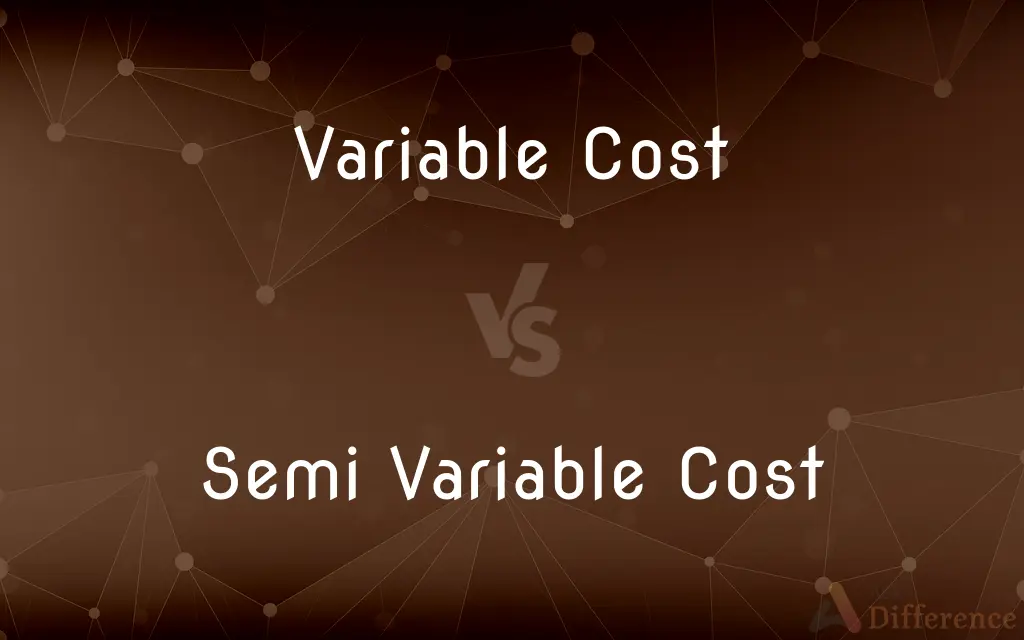Variable Cost vs. Semi Variable Cost — What's the Difference?
By Tayyaba Rehman — Published on October 16, 2023
Variable Cost changes directly with production volume, while Semi Variable Cost has both fixed and variable components, adjusting partly with production changes.

Difference Between Variable Cost and Semi Variable Cost
Table of Contents
ADVERTISEMENT
Key Differences
Variable Cost and Semi Variable Cost are critical concepts in accounting and finance, each having unique characteristics and applications in cost accounting and financial analysis. Variable Cost refers to costs that change directly and proportionally with changes in production or activity level. If a business produces more goods, its Variable Cost increases; if it produces fewer, the cost decreases. On the contrary, Semi Variable Cost encompasses both variable and fixed cost components, making it partially variable and partially fixed, meaning it may increase with production, but not always proportionally.
When discussing Variable Cost, it’s paramount to understand its linear relationship with production levels. As units produced change, Variable Cost changes in direct proportion, making it straightforward and predictable. For example, if it costs $5 in Variable Cost to produce one unit, it will cost $500 to produce 100 units. Semi Variable Cost, however, is characterized by its combination of fixed and variable costs, and these may not change in direct proportion to production or activity changes. It includes a fixed cost that must be paid regardless of production levels, and a variable component that changes with production.
In cost accounting and budgeting, Variable Cost provides a clear-cut measure for marginal costing and cost-volume-profit analysis. Every additional unit produced adds a predictable amount to total costs. In contrast, managing Semi Variable Cost can be slightly complex due to its dual nature. A portion of Semi Variable Cost remains constant even when production levels alter, and another portion changes with alterations in production levels, making the relation non-linear and requiring deeper analysis for budgeting and forecasting.
For decision-making, Variable Cost is often analyzed to understand the cost behavior and to calculate the contribution margin per unit, which aids in pricing strategies and production planning. Since Variable Cost moves in tandem with production, businesses can anticipate how total costs will evolve as production levels shift. Conversely, Semi Variable Cost requires a nuanced approach in decision-making. Since it includes both fixed and variable elements, businesses need to dissect these costs accurately to understand how changes in production will impact the total cost and subsequently, pricing and budgeting decisions.
Understanding Variable Cost and Semi Variable Cost is vital for accurate financial planning, budgeting, and decision-making. While Variable Cost allows businesses to easily compute the total cost of production at different levels, Semi Variable Cost demands a more detailed analysis to ascertain how total costs will vary, thereby ensuring that financial plans and budgets are both robust and flexible enough to accommodate variations in business activity levels.
ADVERTISEMENT
Comparison Chart
Relationship with Production
Direct and proportional
Partly proportional
Components
Only variable component
Both fixed and variable
Predictability
Highly predictable
Less predictable
Cost Behavior
Changes with every unit produced
Changes but not always linearly
Use in Financial Analysis
Marginal costing, CVP analysis
Detailed budget analysis
Compare with Definitions
Variable Cost
Cost altering directly with production volume.
Rising production led to an increase in the Variable Cost for the firm.
Semi Variable Cost
Cost characterized by a static portion and a dynamic portion.
Semi Variable Cost was analyzed to understand fixed and variable elements in total costs.
Variable Cost
Cost that shifts congruently with production alterations.
Lowering production diminished the company's Variable Cost.
Semi Variable Cost
Expense that combines aspects of fixed and variable costs.
Semi Variable Cost in customer support included fixed salaries and variable overtime pay.
Variable Cost
Cost that varies directly with production.
The Variable Cost of producing toys increased during the holiday season.
Semi Variable Cost
Cost having both fixed and variable components.
The Semi Variable Cost for utility bills fluctuated monthly.
Variable Cost
Per-unit cost that changes with output.
The Variable Cost per unit was $10 for manufacturing lamps.
Semi Variable Cost
Expense partially constant and partially variable.
The Semi Variable Cost of vehicle operations included maintenance and fuel costs.
Variable Cost
Expense directly proportional to activity level.
The company experienced higher Variable Cost due to ramped-up production.
Semi Variable Cost
Cost that partly alters with production changes.
In the bakery, the Semi Variable Cost included rent and ingredient costs.
Common Curiosities
What is Variable Cost?
Variable Cost is the cost that changes directly and proportionally with changes in production or service activity.
What characterizes Semi Variable Cost?
Semi Variable Cost is comprised of both fixed and variable components, partially changing with production or activity levels.
How is Variable Cost used in pricing strategies?
Variable Cost per unit is used to calculate contribution margin, aiding in developing pricing strategies.
How is Semi Variable Cost different in cost behavior?
Semi Variable Cost includes a fixed component that remains constant and a variable component that changes with production.
How can Semi Variable Cost impact budgeting?
Semi Variable Cost requires detailed analysis to decipher fixed and variable elements for accurate budgeting.
Can Variable Cost be a Semi Variable Cost?
No, Variable Cost is strictly variable and changes directly with production, without a fixed component.
Can Semi Variable Cost become a Variable Cost?
No, Semi Variable Cost always includes both fixed and variable elements.
How does Variable Cost behave with production changes?
Variable Cost changes in direct proportion to changes in production levels.
Share Your Discovery

Previous Comparison
Domestic Marketing vs. International Marketing
Next Comparison
Bifocal vs. MultifocalAuthor Spotlight
Written by
Tayyaba RehmanTayyaba Rehman is a distinguished writer, currently serving as a primary contributor to askdifference.com. As a researcher in semantics and etymology, Tayyaba's passion for the complexity of languages and their distinctions has found a perfect home on the platform. Tayyaba delves into the intricacies of language, distinguishing between commonly confused words and phrases, thereby providing clarity for readers worldwide.
















































